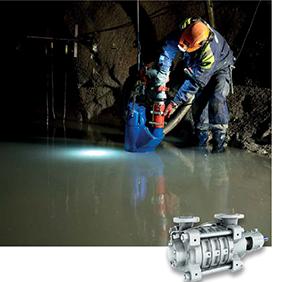Everything you need to know about mine water management
Published on by Water Network Research, Official research team of The Water Network in Technology
Mikael Hjelm explores the latest pump technologies to assist in the operationally critical task of managing mine water
Mines require water. At the same time, because many mine working areas are below the water table, removal of water is a major challenge. Here, we briefly review the concepts of mine water and mine water management as well as the most commonly used pumps for these applications.
Mine dewatering and the dewatering process
The definition of mine water is that it is not a slurry, i.e. generally it is considered to contain <50g/l of solids. Mine water can be categorised into two different streams of water: removal and addition.
The first category involves removal of water from the mine area (mine dewatering) and removal of water from the process (process dewatering). Mine water originates from several sources. Precipitation from rainwater and subsequent floodwater or melting snow generally affects above-ground mining, whereas underground mines are affected by subterranean waterways, ore bodies containing pockets of water, or long-term rise of the water table from precipitation.
Conversely, minerals processing requires the addition of water at various stages, and this can either be reclaimed water from within the mine area or, where not sufficiently available, brought in from external sources such as town water, river
or sea water.
The management of water around the mine site is referred to as mine water management and managing the water resources is a critical task and a major challenge in mining. It is a continuous process, and dewatering operations would normally continue when a mine is operating at reduced capacity or even temporarily shut down.
Challenges in dewatering
The primary objective of a mine dewatering system is to keep the mine sites dry to allow for safe and efficient mining.
To determine the most suitable dewatering method for a specific type of mine, the following challenges and conditions need to be considered:
• Mine type. This generally determines the best dewatering method but may be overruled by end user preferences.
• Location. Mines in remote locations may have reduced access to adequate electrical power. Therefore, alternate technologies need to be considered.
• Incoming volume of water. It is of critical importance to have an accurate estimate of the inflow from all possible sources.
• Mine depth. Whether open pit or underground, the mine depth will determine whether single-lift drainage or a stage pumping system needs to be employed.
• Water properties. This will determine the dewatering system, pump technologies and materials of construction. The type of pumps used depends on various factors, including water quality, chemical composition and solids content.
• Life of mine. If the expected mine life is long, a more permanent system needs to be considered. In a mine with a shorter life span, portable products or a less costly dewatering system can be used.
• Cost budget. The budget available for the dewatering system defines which methods can be considered.
What is mine dewatering?
There are two main types of mine dewatering, i.e. active and reactive (or passive). Active dewatering is a process used mainly around open-pit mines with the purpose of lowering the water table. It reduces ingress and seepage of water into the mine areas, allowing safe and uninterrupted work. The technologies used are multi-stage deep well pumping or well-pointing.
Reactive dewatering is used to remove water from working areas and is applicable to both open-pit and underground mines. Multiple pump technologies can be used in these applications, including submersible, vertical, end-suction, multistage or volumetric pumps. The pump type and construction materials depend on various factors, such as water properties, the presence of abrasive solids, the concentration of solids and the location of the installation.
What is process dewatering?
Process dewatering generally refers to the separation of water from solids towards the later part of minerals processing. Slurry pumps are normally used for pumping the process water to various types of filters or into thickening and settlement tanks.
What is process water and treatment?
Large quantities of water may be required in minerals processing. The quality of the water is highly important and therefore some level of treatment is needed before it enters the process. A combination of vertical, horizontal and submersible pumps may be used in the treatment process, and the water source, e.g. sea water, reclaimed water, etc. may affect the materials of construction used. The treated water is then added to the process at various stages.
Intake water technology requirements
Because intake water stations may transport water into the mine from various types of sources, the technology requirements will vary accordingly. Vertical turbines and horizontal end-suction pumps are most commonly used, depending on the pump station design and configuration.
Reclaimed water and reuse
The scarcity and cost of water means that reclaiming and reuse are on the increase. Water is reclaimed from tailings ponds, lagoons and the downstream of minerals processing by vertical, horizontal and submersible pumps. It is treated prior to use.
Water may be a nuisance, but it is also essential for the mining process. The management of this precious resource is of critical importance. Sulzer offers a comprehensive portfolio of innovative pumps and agitators for mining applications, from lightweight and robust submersible dewatering pumps to wear-resistant high-lift centrifugal pumps for the removal of sludge, mud, silt, and water in abrasive and corrosive environments.
Mikael Hjelm is with Sulzer
Taxonomy
- Open Pit Dewatering
- Dewatering
- Mining Development
